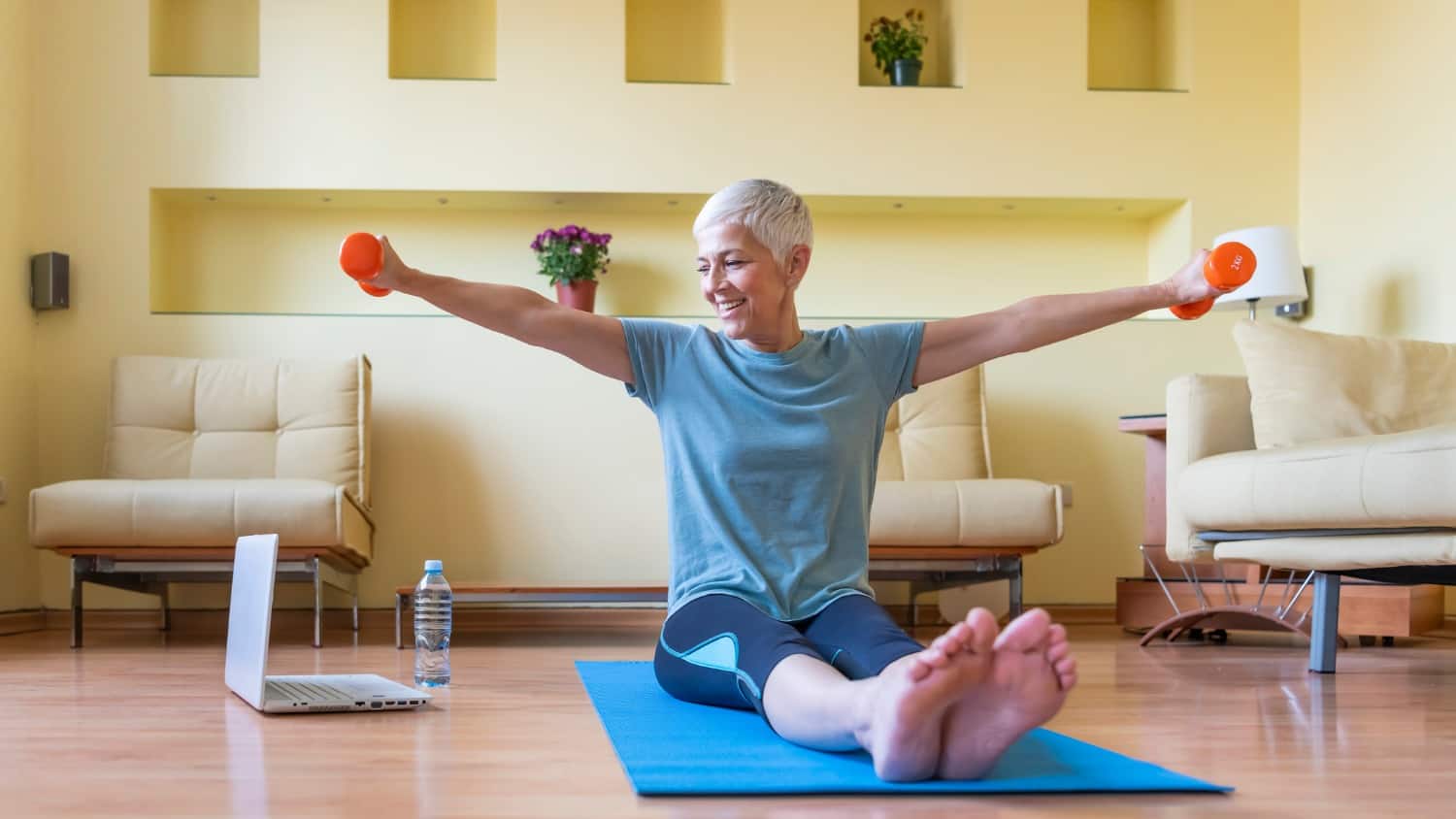3 Simple Tips to Fit Any Exercise Program to Your Fitness Level After 60 (#3 Will Reduce Pain)
I recently watched a YouTube video makeup tutorial created by a 30-year-old makeup artist. She lamented about how she couldn’t believe she was “that old” and how depressed she felt over her ancient-ness.
Her thousands of followers remarked that she “didn’t look anywhere near 30!” in efforts to soothe her in her deep despair.
At that point, I stopped watching. It was either that – or fling the computer out my window. I decided it wasn’t worth the angst – or the price of a new iMac.
Time Isn’t Partial
In fact, here’s the ultimate truth: The clock stops ticking for no one. One day, that young lady will realize the ridiculousness of the whole conversation. Or not.
But I get it. At 30 (let’s have a moment of silence for that memory), it’s hard to imagine you’ll ever feel anything but energetic, youthful, fit and able to get up off the floor without looking around for something to grab onto.
As someone who’s been a fitness pro and Certified Strength and Conditioning Specialist (CSCS) for over 20 years – and an avid exerciser for the past 38 – I can tell you this: Things change. Some you can control, others not so much.
A huge part of being happy with your body lies in doing the best you can and accepting the handful of things out of your control.
For the latter, we have Spanx.
Some Inevitable Changes
And yes, when we talk about fitness and our physical bodies, some changes do occur that we can’t do a whole lot about.
These include the following facts:
- You need twice the recovery time as you did in your 30s (two days between workouts may be necessary now versus one day in earlier years).
- Tendons become less hydrated and more ‘brittle’, so tendonitis becomes more common with age.
- Warmups become more important than ever – especially if you have arthritis – to get yourself moving without injury.
The most important bottom line: You can still do a lot of the same exercises if you know how.
As someone with osteoarthritis, and a couple other health issues associated with the aging process, I’ve had to shift to a lower gear on a few things myself.
The key lies in focusing on what you CAN do.
Here are a few general tips for making adjustments when you’re less than 100%.
Most Importantly: Warm Up Thoroughly
It’s easy to skip your warmup to save a few minutes, but if you’re out of commission with a strained muscle for a few weeks, you’ll wish you’d taken the time.
Warmups prepare your body for exercise by priming your nervous system, increasing muscle temperature and core temperature and overall increasing blood flow to muscles.
Choose a light cardiovascular exercise of your choice, be it walking in place, pedaling on a stationary bike or otherwise moving your joints. A warmup of about 10 minutes should do it. You should just start to break a sweat.
NOTE: Stretching is NOT a form of warming up. In fact, you should only stretch after your workout or after your warmup. Stretching a cold muscle increases risk of straining or even tearing a muscle. Only stretch a warm muscle.
Here are three easy ways you could modify most exercises:
Slow Down
Slowing down seems like common sense but it’s often not. Take your time and focus on each phase of the exercise, even if you’re simply walking. We often work out surrounded by distractions and can easily forget to pay attention to what we’re doing and get hurt.
Instead of swinging and using momentum while lifting weights, for example, count to yourself (or aloud if you’re not afraid to get a few looks) from one to five for both the lifting and the lowering phase.
Reduce Your Range of Motion
Quite often, pain happens at a particular point in the exercise, such as at the bottom phase of a squat or top part of a biceps curl. To evade the pain, simply stop the repetition before you get to that point. In other words, stay within a pain-free zone. Go halfway down or otherwise shorten the movement.
Ditto for exercises such as step-ups. Reduce the height of the step if knee pain kicks in at higher levels.
Shift the Resistance
When an exercise brings more stress to a joint, it’s time to shift the resistance. Though this one’s a little trickier to explain, the key is to remember that the stress grows the further the resistance is from the joint. So, by shortening the distance, you reduce the stress and, likely, the risk of discomfort.
In other words, performing a lateral walk with tubing wrapped around your legs is harder on the knee joint if you secure the tubing around your ankles versus above the knee joint. Keep resistance above the knee if you have arthritic knees like me.
The same is true about the shoulders. When doing a lateral raise (lifting dumbbells out to the sides until they’re parallel to the ground), tuck the dumbbell into the crook of your arms – instead of holding them with your hands – and keep the arms bent.
Lastly, always be sure to take time to cool down and stretch or use a foam roller when you’re finished.
If you’d like more specific tips, be sure to sign up for my FREE and very popular webinar, How to Firm Up After 50. It will answer many questions you may have about resistance training after 50. Or click HERE for a downloadable workout you can do at home.
What modifications have you made to your workout in times of achy breaky muscles and tendons? Will you try one of these three suggestions? Please join the conversation!
Tags Fitness Over 60






